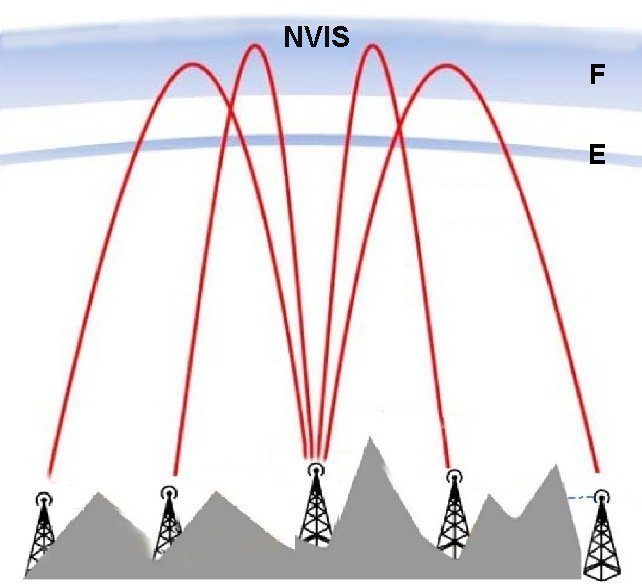- Hits: 1332
Introduction: What Is NVIS?
Near Vertical Incidence Skywave (NVIS) is a specialized HF propagation method where signals are sent almost straight up and refracted back down by the ionosphere—ideal for reliable communication within a few hundred miles, filling the gap between VHF line-of-sight and long‑distance skip modes. Learn More
Why NVIS Matters for Bald Rock ARC
NVIS is perfect for Alabama’s varied terrain — hills, hollows, and pockets of sparse repeater coverage. During emergencies (like severe weather events), clubs and ARES teams can seamlessly pass traffic county‑to‑county without relying on repeaters or infrastructure .
Antennas & Frequency Selection
- Bands: 40 m during the day and 75/80 m at night hit the NVIS sweet spot (1.8–8 MHz range) More at wikipedia.com
- Dipoles: Use a horizontal dipole or inverted‑V mounted just 0.1–0.25λ above ground—approximately 10–15 ft on 40 m and 5–10 ft on 80 m. Join the conversation at reddit.com
- Reflector ground screen: Laying a grounded wire reflector below the dipole can increase performance by 3–6 dB. See results from ZL2AL's antenna tests.
- Alternative setups: Consider horizontal loops or modified military NVIS masts for better gain in field operations.Watch this YouTube video for more
Real-World Success & Tactical Advantages
NVIS has deep roots in military and emergency comms—used for jungle ops, hurricane relief, and by ARES groups during power and repeater outages. It has stealth benefits (harder to geolocate/jam) and works reliably at low power.
How to Test NVIS With Bald Rock ARC
- Plan a Mini-Test Day: Schedule a test focusing on NVIS—set up dipoles at 10', compare signal reports.
- Rotate Frequencies & Heights: Try 40 m at midday, 75 m at night; experiment with antenna height for optimum contact reports .
- Log & Review: Use tools like PSKReporter or QRZ to collect signal reports, then analyze coverage maps.
- Share & Report: Encourage other operators to test in their yards, tag #BaldRockARC on social media, and present findings at the next club meeting.
Visual Aids

Illustration of vertical vs angled radiation reflecting off the ionosphere (see image above)

Side view of a 40 m dipole at ~10 ft height
Conclusion
NVIS is a practical, resilient, and cost‑effective HF option for Bald Rock ARC, especially for emergency communications and local nets. A club “NVIS Day" is easy to organize, low-cost, and educational—perfect for hands-on learning and community readiness.
- Hits: 1370
Why Portable Ops?
 Field Day isn’t just a contest—it’s a hands-on, emergency-communications drill where hams set up stations in parks, fields, or even backyard spaces and run off batteries, generators, or solar power.
Field Day isn’t just a contest—it’s a hands-on, emergency-communications drill where hams set up stations in parks, fields, or even backyard spaces and run off batteries, generators, or solar power.
A portable setup puts training into practice and keeps us ready when disaster strikes.
Choosing Your Location & Layout
 Scout a spot with solid ground, some shade, and antenna-friendly surroundings—trees or light poles help raise antennas. Map out a layout for your radio, power source, table, and seating. A pop-up canopy offers comfort and weather protection. Use FT8 or CW on a simple wire dipole for easy portable operations onallbands.com .
Scout a spot with solid ground, some shade, and antenna-friendly surroundings—trees or light poles help raise antennas. Map out a layout for your radio, power source, table, and seating. A pop-up canopy offers comfort and weather protection. Use FT8 or CW on a simple wire dipole for easy portable operations onallbands.com .
Read more: Embrace the Outdoors: Portable Field Day Operations
- Hits: 5738
Have you ever wondered why radio waves seem to get weaker the further you get from the source of the waves? Well, they don't! They only appear to be weaker because they are spread over a larger area. This can be demonstrated by the inverse square law.
The inverse square law is a fundamental principle in physics that describes the relationship between the intensity of a phenomenon and the distance from its source. According to this law, the intensity of a phenomenon decreases in proportion to the square of the distance from its source. In other words, if you double the distance from the source, the intensity of the phenomenon decreases to one-fourth of its original value (i.e., 1/22); if you triple the distance, the intensity decreases to one-ninth of its original value (i.e., 1/32), and so on.
Read more: Why Do Radio Waves Get Weaker As They Travel Over Distance?
